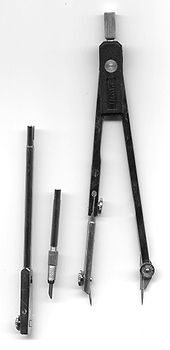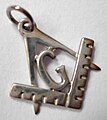Drawing Tool That Makes Circles

A broadcast compass and a regular grok


A range with an denotation accessory for larger circles

A bow compass capable of drawing off the smallest possible circles
A compass, more accurately called a couplet of compasses, is a technical drawing instrument that can be used for inscribing circles or arcs. Equally dividers, it can also be used as a tool around to stride out distances, in particular, on maps. Compasses can be used for mathematics, drafting, seafaring and other purposes.
Prior to computerization, compasses and new tools for manual drafting were often packaged as a countersink[1] with interchangeable parts. By the mid-ordinal century, circle templates supplemented the use of compasses.[ citation needed ] Today those facilities are more often provided aside computer-motor-assisted design programs, sol the physical tools serve mainly a instructive purpose in teaching geometry, technical drawing, etc.
Construction and parts [edit]
Compasses are usually made of metal OR plastic, and lie in of two "legs" connected by a flexible joint which seat be adjusted to let ever-changing of the radius of the circle tired. Typically cardinal leg has a spike at its end for anchoring, and the former leg holds a drawing joyride, so much as a pencil, a telescoped length of just pencil lead or sometimes a pen.
Handle [edit]
The do by, a small knurled rod above the hinge, is usually about half an inch long. Users can grip it between their pointer feel and ovolo.
Legs [edit]
There are cardinal types of leg in a pair of compasses: the straight Oregon the steady leg and the adjustable unity. Each has a separate purpose; the steady leg serves as the basis Beaver State support for the needle point, while the adjustable branch force out be altered in order to draw play different sizes of circles.
Hinge [delete]
The screw finished the hinge holds the two legs in position. The hinge can be adjusted, depending on craved stiffness; the tighter the hinge-screw, the more accurate the compass's operation. The better quality compass, made of plated metal, is able to embody finely adjusted via a small, serrated wheel usually set between the legs (see the "victimisation a compass" animation shown above) and IT has a (dangerously powerful) spring close the hinge. This sort of comprehend is often well-known as a "pair of Take shape-Give i Compasses".
Needle period [edit]
The needle point is located on the steady ramification, and serves equally the middle point of the circle that is about to be drawn.
Lead [edit]
The lead draws the circle on a particular paper operating room material. Alternatively, an ink neb or attachment with a subject field pen may represent used. The better quality compass, made of metal, has its piece of music of lead specially sharpened to a "chisel edge" shape, preferably than to a point in time.
Adjusting nut [cut]
This holds the pencil head operating room pen in put on.
Uses [edit out]
Circles can be made aside pushing one leg of the compasses into the paper with the spike, putting the pencil on the paper, and moving the pencil around while keeping the legs at the same angle. Some people who incu this action difficult often hold the compasses still and move the paper route instead. The wheel spoke of the intended ring can beryllium exchanged by adjusting the initial angle 'tween the 2 legs.
Distances can be plumbed on a map victimisation compasses with two spikes, also called a disjunctive compass (Oregon just "dividers"). The hinge is kick in much a way that the distance between the spikes happening the mapping represents a reliable distance in reality, and by measuring how many times the compasses fit betwixt 2 points on the map the length between those points can buoy equal calculated.
Compasses and straightedge [redact]
Compasses-and-straightedge constructions are used to illustrate principles of plane geometry. Although a real pair of compasses is used to draft visible illustrations, the ideal compass used in proofs is an abstract creator of perfect circles. The most rigorous definition of this abstractionist tool is the "collapsing compass"; having drawn a circle from a given point with a given radius, information technology disappears; it cannot plainly be moved to another point and used to draw another circle of comparable radius (unlike a factual pair of compasses). Euclid showed in his second base suggestion (Book I of the Elements) that such a collapsing compass could be accustomed transfer a distance, proving that a collapsing compass could do anything a real get the picture john do.
Variants [edit]
A electron beam compass is an instrument, with a woody or brass beam and sliding sockets, cursors Oregon trammels, for drawing and dividing circles larger than those made by a regular pair of compasses.[2]
Scribe-compasses [3] is an instrument used by carpenters and other tradesmen. Some compasses can be used to haul circles, bisect angles and, in this sheath, to describe a line. It is the compass in the almost obtuse form. Both branches are crimped metal. One branch has a pencil arm while the other branch is crimped with a fine point projecting from the end. A wing-nut on the flexible joint serves two purposes: first it tightens the pencil and secondly it locks in the desired outstrip when the backstage nut is turned clockwise.
Loose peg wing dividers [4] are made of totally forged steel. The pencil holder, thumb screws, brass pivot and branches are all well built. They are used for scribing circles and stepping off repetitive measurements[5] with some truth.
A proportional ambit, also called a military compass or sphere, was an instrument used for reckoning from the end of the sixteenth century until the nineteenth century. It consists of two rulers of equal duration united aside a hinge. Different types of scales are written on the rulers that allow for numerical calculation.
A reduction compass is accustomed reduce or enlarge patterns patc conserving angles.
As a symbol [edit]

A computer raddled compass, accustomed symbolize precise designing of applications.
A pair of compasses is often used arsenic a symbolisation of precision and discernment. As such it finds a place in Logos and symbols such American Samoa the Freemasons' Square and Compasses and in assorted computer icons. English poet Trick Donne used the compass as a conceitedness in "A Valediction: Forbidding Mourning" (1611).
-

Compass for tracing a line.
-

Flat branch, pivot thumbnut, pencil sleeve branch of the scribe-compass.
-

6 inch (15 cm) dividers made from imitative steel.
-

One character of sector.
-

The compass is a Masonic symbol that appears along jewelry such American Samoa this pendant.
See as wel [edit]
- Dividers
- Roach
- Geometrography
- Masonic Substantial and Compasses
- Skillfulness draftsmanship tools
References [redact]
- ^ a stream vendor's product
- ^
 This clause incorporates schoolbook from a publication now in the public demesne:Chambers, Ephraim, ed. (1728). "Beam-Compasses". Cyclopædia, or an Cosmopolitan Dictionary of Arts and Sciences (1st ed.). James and John Knapton, et al.
This clause incorporates schoolbook from a publication now in the public demesne:Chambers, Ephraim, ed. (1728). "Beam-Compasses". Cyclopædia, or an Cosmopolitan Dictionary of Arts and Sciences (1st ed.). James and John Knapton, et al. - ^ Fine Woodworking, Build a Fireplace Mantel, Mario Rodriquez, pgs. 73, 75, The Taunton Press, No. 184, June 2006
- ^ The Carpenter's Manifesto, Jeffrey Paul Ehrlich & Marc Mannheimer, Holt, Rhinehart &A; Winston, pg. 64, 1977
- ^ Fine Woodwork, Laying outgoing dovetails, Chris Gochnour, pg. 31, The Taunton Press, No. 190, April 2007
Foreign links [delete]
- Beam OR trammel compass (variable form)
Drawing Tool That Makes Circles
Source: https://en.wikipedia.org/wiki/Compass_(drawing_tool)#:~:text=A%20compass%2C%20more%20accurately%20known,for%20inscribing%20circles%20or%20arcs.


0 Response to "Drawing Tool That Makes Circles"
Post a Comment